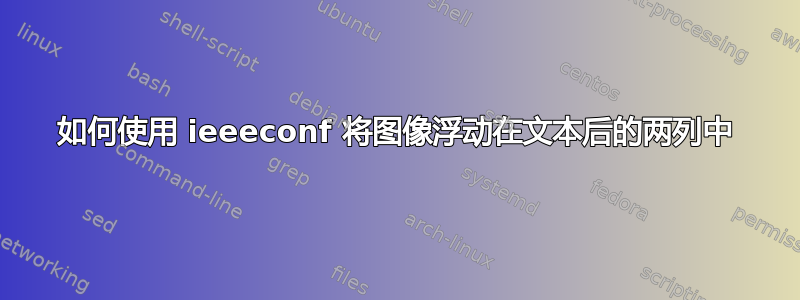
我已经进行过研究,并且尝试了一些方法,以便使用 \documentclass[letterpaper, 10 pt, conference]{ieeeconf} 实现与附图所示的相同的效果,但仍然无法完成。
我尝试了 [h]、[!]、[H] 的组合,但都不起作用
目前,我有浮动两列的图像,但我的图像被放在了文档的最后一页。
\begin{figure*}
\centering
\includegraphics[scale=.085]{figure/HD01.JPG}
\caption{ Experimental Setup }
\label{fg:v1}
\end{figure*}
工作示例:
答案1
新的解决方法......但是它是“手动”修复空格,所以不建议......如果你找不到更好的方法,我只是写了另一个答案作为最后的解决方案......它适用于两栏文章,所以我想它也适合你...但是在你完成本章(或一个已知的开始新页面)中的所有内容后使用它......否则你会在工作过程中一次又一次地修复空格......
以下是代码:
\documentclass[twocolumn]{article}
\usepackage{graphicx}% http://ctan.org/pkg/graphicx
\usepackage{float}
\usepackage{multicol}
\begin{document}
\section{First section}
Single column
Like TeX, LaTeX started as a writing tool for mathematicians and computer scientists, but from early in its development it has
\section{Second section}
Twocolums section
LaTeX can be arbitrarily extended by using the underlying macro language to develop custom formats. Such macros are often
collected into packages, which are available to address special formatting issues such as complicated mathematical content or graphics.
Indeed, in the example below, the align environment is provided by the amsmath package.
Breaking Twocolums in this place
%\twocolumn[
\begin{@twocolumnfalse}
\begin{minipage}{\textwidth}
\hspace*{130pt}\begin{figure}[H]
\centering
\includegraphics[width=0.8\textwidth]{Longpic.png}
\caption{This is a figure caption}
\end{figure}
\end{minipage}
\end{@twocolumnfalse}
%]
Going back to Twocolums
\LaTeX{} is a document preparation system for
the \TeX{} typesetting program. It offers
programmable desktop publishing features and
extensive facilities for automating most
aspects of typesetting and desktop publishing,
including numbering and cross-referencing,
tables and figures, page layout,
bibliographies, and much more. \LaTeX{} was
originally written in 1984 by Leslie Lamport
and has become the dominant method for using
\TeX; few people write in plain \TeX{} anymore.
The current version is \LaTeXe.
LaTeX can be arbitrarily extended by using the underlying macro language to develop custom formats. Such macros are often
collected into packages, which are available to address special formatting issues such as complicated mathematical content or graphics.
Indeed, in the example below, the align environment is provided by the amsmath package.
LaTeX can be arbitrarily extended by using the underlying macro language to develop custom formats. Such macros are often
collected into packages, which are available to address special formatting issues such as complicated mathematical content or graphics.
Indeed, in the example below, the align environment is provided by the amsmath package.
LaTeX can be arbitrarily extended by using the underlying macro language to develop custom formats. Such macros are often
collected into packages, which are available to address special formatting issues such as complicated mathematical content or graphics.
Indeed, in the example below, the align environment is provided by the amsmath package.
LaTeX can be arbitrarily extended by using the underlying macro language to develop custom formats.\vspace*{155pt}
Such macros are often
collected into packages, which are available to address special formatting issues
such as complicated mathematical content or graphics.
Indeed, in the example below, the align environment is provided by the amsmath package.
\end{document}
结果继续按照您请求的照片进行(继续第一列,然后转到第二列)。
答案2
您可以尝试将“multicol”包与“float”组合...请参阅我的示例:
\documentclass{article}
\usepackage{graphicx}% http://ctan.org/pkg/graphicx
\usepackage{float}
\usepackage{multicol}
\begin{document}
\section{First section}
Single column
Like TeX, LaTeX started as a writing tool for mathematicians and computer scientists, but from early in its development it has
also been taken up by scholars who needed to write documents that include complex math expressions or non-Latin scripts,
such as Arabic, Sanskrit and Chinese[citation needed].
LaTeX is intended to provide a high-level language that accesses the power of TeX in an easier way for writers. In short,
TeX handles the layout side, while LaTeX handles the content side for document processing. LaTeX comprises a collection
of TeX macros and a program to process LaTeX documents. Because the plain TeX formatting commands are elementary,
it provides authors with ready-made commands for formatting and layout requirements such as chapter headings, footnotes,
cross-references and bibliographies.
\section{Second section}
\begin{multicols}{2}
Twocolums section
LaTeX can be arbitrarily extended by using the underlying macro language to develop custom formats. Such macros are often
collected into packages, which are available to address special formatting issues such as complicated mathematical content or graphics.
Indeed, in the example below, the align environment is provided by the amsmath package.
Breaking Twocolums in this place
\end{multicols}
\begin{figure}[H]
\centering
\includegraphics[width=0.4\textwidth]{Sc1.png}
\caption{This is a figure caption}
\end{figure}
\begin{multicols}{2}
Going back to Twocolums
\LaTeX{} is a document preparation system for
the \TeX{} typesetting program. It offers
programmable desktop publishing features and
extensive facilities for automating most
aspects of typesetting and desktop publishing,
including numbering and cross-referencing,
tables and figures, page layout,
bibliographies, and much more. \LaTeX{} was
originally written in 1984 by Leslie Lamport
and has become the dominant method for using
\TeX; few people write in plain \TeX{} anymore.
The current version is \LaTeXe.
\end{multicols}
\end{document}





